Nestled in the heart of Yunnan Province, China, lies Chuxiong Yi Autonomous Prefecture—a region where rugged mountains meet lush valleys, and ancient traditions intertwine with vibrant modernity. While often overlooked by international travelers in favor of better-known destinations like Kunming or Lijiang, Chuxiong boasts a culinary landscape as diverse and captivating as its terrain. Rooted in the traditions of the Yi people, the largest ethnic group in the region, and influenced by neighboring Han, Bai, and Miao communities, Chuxiong’s cuisine is a symphony of bold flavors, textural contrasts, and time-honored techniques. This article delves into the soul of Chuxiong’s gastronomy, exploring its iconic dishes, indigenous ingredients, and the cultural rituals that make every meal a celebration of heritage.
The Foundations of Chuxiong’s Cuisine: Nature’s Bounty
Chuxiong’s geography—a mosaic of forests, rivers, and highland plateaus—shapes its cuisine in profound ways. The subtropical climate and fertile soil nurture a staggering variety of crops, from fragrant rice to spicy chili peppers, while the surrounding mountains yield wild mushrooms, game, and medicinal herbs. Local chefs and home cooks alike rely on these natural resources, transforming them into dishes that are both nourishing and deeply symbolic.
Wild Mushrooms: The “Diamonds” of the Forest
Yunnan is famed as China’s mushroom kingdom, and Chuxiong is no exception. Each rainy season, locals venture into the mist-shrouded forests to forage for rare varieties like matsutake, morels, and the coveted tricholoma giganteum. These fungi are not merely ingredients but cultural icons, often featured in banquets and festivals. A simple stir-fry of mushrooms with garlic and chili might seem humble, but in Chuxiong, it’s a tribute to the land’s generosity.
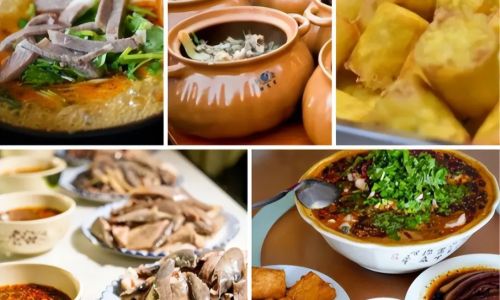
Soybean Alchemy: The Yi People’s Legacy
The Yi people have cultivated soybeans for centuries, mastering the art of fermentation to create staples like doubanjiang (spicy bean paste) and doufu (tofu). Chuxiong’s tofu is renowned for its silken texture and earthy flavor, often grilled over open flames until puffed and charred, then doused in a dipping sauce of chili oil, cilantro, and soy sauce. For the Yi, tofu is more than sustenance—it’s a symbol of resilience, having sustained generations through harsh winters.
Livestock and Game: From Pasture to Plate
Highland cattle, free-range pigs, and wild fowl are central to Chuxiong’s carnivorous delights. The region’s signature dish, Yongren Roasted Duck, exemplifies this tradition. Marinated in honey, wine, and spices, the duck is roasted until the skin crackles like glass, its flesh tender and infused with smoky sweetness. Similarly, steam pot chicken—a whole bird steamed with medicinal herbs in a sealed clay pot—is prized for its healing properties and comforting warmth.
Iconic Dishes: Where Tradition Meets Innovation
Chuxiong’s culinary repertoire is a blend of rustic peasant food and refined banquet fare, with dishes that tell stories of migration, trade, and cultural exchange.
Steam Pot Chicken (Qiguo Ji)
Often dubbed the “crown jewel” of Chuxiong cuisine, steam pot chicken is a testament to the region’s resourcefulness. The dish is prepared by sealing a whole chicken, ginger, salt, and local herbs inside a clay pot, which is then submerged in a larger pot of boiling water. As steam circulates, the chicken cooks in its own juices, resulting in meat so tender it falls off the bone. The broth, golden and fragrant, is believed to cure fatigue and boost immunity—a claim that has made it a staple at postpartum meals and winter feasts.
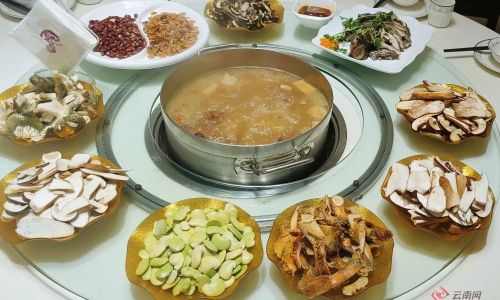
Sour Soup Fish (Suan Yu Tang)
Chuxiong’s version of this Yunnan classic reflects the Yi people’s love for tangy, fermented flavors. Fresh carp or catfish is simmered in a broth of pickled mustard greens, tomatoes, and chili, creating a soup that balances sourness, spice, and umami. Served with a side of steamed rice and wild herbs, it’s a dish that awakens the palate and invigorates the spirit.
Crossing-the-Bridge Noodles (Guoqiao Mixian)
Though originating in neighboring Mengzi, this interactive dish has become a Chuxiong favorite. A simmering bowl of chicken or pork broth is served alongside a plate of rice noodles, thinly sliced meats, quail eggs, and fresh vegetables. Diners add ingredients to the broth one by one, watching as they cook in the hot liquid. Legend has it that the dish was invented for a scholar’s wife who needed to keep his soup warm while she crossed a bridge to deliver it—a tale that adds romance to every slurp.
Wild Mushroom Hotpot
During monsoon season, Chuxiong’s restaurants buzz with the aroma of simmering mushroom hotpots. Diners choose from baskets of freshly foraged fungi—from meaty king oyster mushrooms to delicate enoki—and cook them in a clear broth flavored with ham and herbs. The result is a broth that grows richer with each addition, a communal experience that celebrates the forest’s fleeting gifts.
Culinary Techniques: Fire, Fermentation, and Time
Chuxiong’s cooks employ age-old methods that elevate simple ingredients into extraordinary meals.
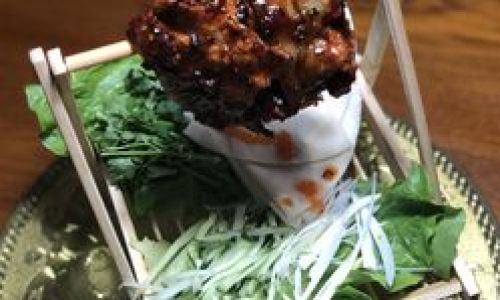
Stone-Pot Cooking
Inspired by the Yi’s nomadic past, stone-pot cooking involves heating a thick-walled clay pot over an open fire until it’s scorching hot. Ingredients like meat or vegetables are then added, searing quickly to lock in moisture and flavor. The technique is used in dishes like Shiba Cai (Eighteen Vegetables), a medley of seasonal produce stir-fried in a stone pot until caramelized and tender.
Fermentation: The Art of Patience
Fermentation is central to Chuxiong’s larder. Beyond soy products, locals preserve vegetables, meats, and even grains using salt, chili, and time. Suancai (pickled mustard greens) and zaope (fermented glutinous rice) are essential condiments, adding depth to stews and stir-fries. The Yi also make jiubiang, a fiery chili paste fermented with rice wine, which fuels their love for bold, spicy flavors.
Open-Fire Grilling
Grilling over wood fires imparts a smokiness that defines Chuxiong’s meat dishes. The aforementioned roasted duck, as well as skewers of lamb or pork marinated in honey and five-spice, are cooked until the fat renders and the skin crisps. The technique harks back to ancestral practices, where fire was both a tool and a sacred element.
Cultural Significance: Food as Ritual
In Chuxiong, meals are never just about sustenance—they’re opportunities to honor ancestors, strengthen community bonds, and mark life’s milestones.
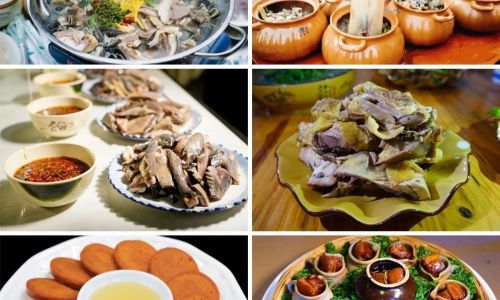
The Torch Festival Feast
Held annually in June, the Yi people’s Torch Festival is a three-day celebration of fire, dance, and feasting. Families gather to roast whole lambs on spits, share jars of baijiu (rice wine), and offer sacrifices of rice and meat to ancestral spirits. The festival’s centerpiece is the Torch Chicken—a bird stuffed with herbs, wrapped in banana leaves, and roasted in embers until juicy and fragrant.
Wedding Banquets: A Feast for 100
Yi weddings are elaborate affairs, with banquets lasting days. Dishes like Eight Treasures Steamed Pork (a layered casserole of pork belly, glutinous rice, and jujubes) and Steamed Fish with Chili Oil are served in abundance, symbolizing prosperity and fertility. The groom’s family traditionally presents the bride’s family with a whole roasted pig—a gesture of respect and goodwill.
Everyday Rituals: Breakfast with a View
Even daily meals carry ritualistic weight. A typical Chuxiong breakfast might include ruanmian (rice noodles in broth) topped with minced pork, pickled vegetables, and a sprinkle of fried garlic. Eaten while watching the sun rise over the mountains, it’s a moment of quiet connection to the land.
Chuxiong’s Culinary Future: Balancing Tradition and Modernity
As China modernizes, Chuxiong’s cuisine faces pressures to adapt. Young chefs are experimenting with fusion dishes, like matsutake mushroom tacos or tofu cheesecake, while preserving traditional techniques. Meanwhile, food tourism is booming, with visitors flocking to night markets in Chuxiong City to sample chǎo mǐàn (stir-fried rice noodles) and shāo kǎo (grilled skewers) from street vendors.
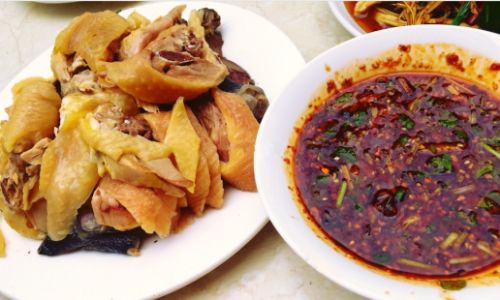
Yet, the heart of Chuxiong’s gastronomy remains in its villages, where grandmothers still pound chili paste with mortar and pestle, and festivals revolve around communal cooking pits. To safeguard this heritage, local governments have launched initiatives to protect traditional recipes and promote sustainable foraging practices, ensuring that future generations can savor the flavors of their ancestors.
Conclusion: A Taste of Eternity
Chuxiong’s cuisine is a mirror to its soul—wild, resilient, and endlessly creative. From the smoky aroma of roasted duck to the tangy kick of sour soup, each dish tells a story of survival, adaptation, and joy. To eat in Chuxiong is to partake in a living archive, where every bite connects us to the mountains, rivers, and people who have shaped this corner of Yunnan. As the world hurtles toward the future, Chuxiong’s tables remain anchored in tradition, offering a timeless reminder that food is not just fuel, but the essence of what it means to be human.
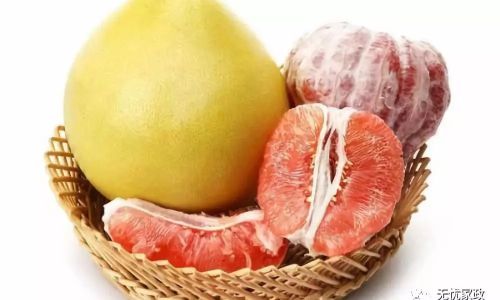
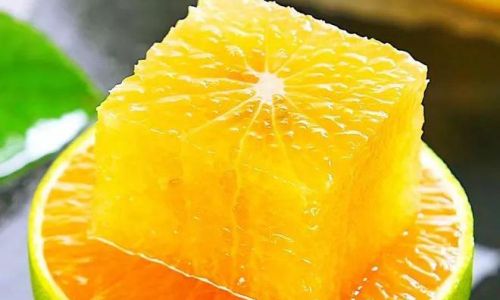




0 comments